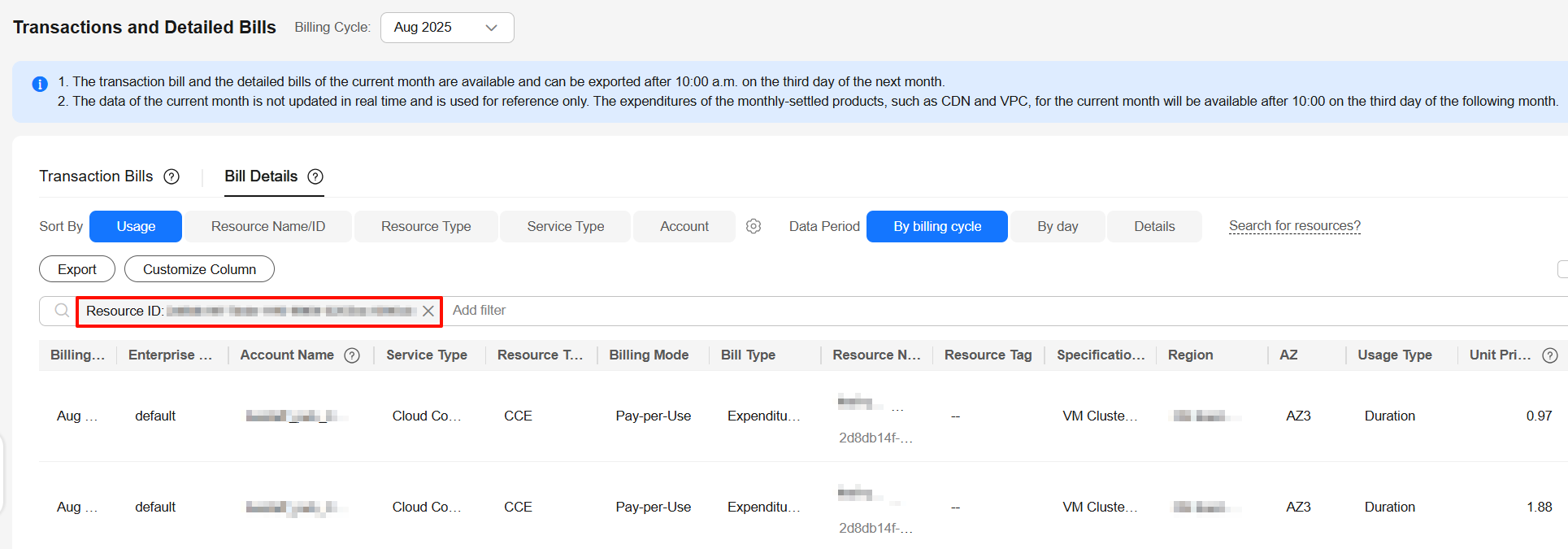Bills
You can view the resource usage and bills for a different billing cycle under Billing in Billing Center.
Bill Generation
Transaction records for yearly/monthly subscriptions are generated immediately after being paid for.
A pay-per-use resource is billed by the hour, day, or month, depending on the resource's usage type. The CCE resource usage is billed by the hour.
You are not charged immediately after a record is generated. For example, if a pay-per-use ECS (which is billed on an hourly basis) is deleted at 08:30, you will still have expenditures for the 08:00 to 09:00 hour, but you will not be billed for the 08:00 to 09:00 hour until about 10:00. On the Bills page of the Billing Center, select the Bill Details tab. Expenditure Time in the bill indicates the time when the pay-per-use resource is used.
Viewing Bills of a Specific Resource
This section uses a CCE cluster as an example to describe how to view the bill of a specified resource.
- Log in to the CCE console and click the cluster name to access the cluster console.
- On the cluster overview page, copy the cluster ID.
Figure 1 Obtaining the cluster ID

- Go to the Expenditure Details.
- Select Resource ID as the filter, enter the ID obtained in step 2, and click
 .
Figure 2 Searching for a bill
.
Figure 2 Searching for a bill
In this example, the bill details are displayed by usage and billing cycle. You can also select other statistical dimensions or periods.
Checking the Consistency of the Actual Usage and Billed Usage
Assume that you purchased a pay-per-use cluster with 50 worker nodes and multiple master nodes at 10:09:06 on April 8, 2023 and deleted it at 12:09:06 on April 8, 2023.
- Transaction Records
Pay-per-use CCE clusters are calculated by the second but billed every hour. You can check the transaction records against the actual usage. For details, see Table 1.
Table 1 Cluster transaction records Service Type
Cloud Container Engine (CCE)
Resource Type
CCE
Billing Mode
Pay-per-Use
Expenditure Time
For the period of time from 10:09:06 to 12:09:06, three transaction records would be generated for the resource usage in the following periods:
- 2023/04/08 10:09:06 - 2023/04/08 11:00:00
- 2023/04/08 11:00:00 - 2023/04/08 12:00:00
- 2023/04/08 12:00:00 - 2023/04/08 12:09:06
List Price
List price on the official website = Unit price of the cluster flavor x Required duration
In this example, the cluster was used for 3,054 seconds in the first period. If the unit price is $0.54 USD/hour, the list price is calculated as follows: 0.54 x (3054/3600) = $0.4581 USD. Similarly, you can calculate the list price for the other periods.
For details, see CCE Pricing Details.
Discounted Amount
Discounts offered for cloud services, for example, commercial discounts, partner authorized discounts, and promotional discounts. It is the discounted amount based on the list price.
Truncated Amount
Huawei Cloud billing is calculated to the 8th decimal place. However, the amount due is truncated to the 2nd decimal place. The third and later decimal places are referred to as the truncated amounts.
Take the first period as an example. The truncated amount is $0.0081 USD.
Amount Due
Amount due = List price – Discount amount – Truncated amount
Take the first period as an example. If the discount amount is 0, the amount due is $0.45 USD (0.4581 – 0 – 0.0081).
- CCE bill details
Bill details can display in multiple ways. By default, the bill details of a resource are displayed by usage and by billing cycle. Table 2 illustrates the CCE bill details, which can be used to check against the actual usage.
Table 2 Cluster bill details Service Type
Cloud Container Engine (CCE)
Resource Type
CCE
Billing Mode
Pay-per-Use
Resource Name/ID
Specific cluster name and ID.
Example: cce-test, 4cdeb1cd-7071-4890-9ce4-e6c2299e960e
Specifications
Cluster scale and HA
Example, VM Cluster (High Availability) | 1-50 nodes
Usage Type
Duration for a pay-per-use CCE cluster
Unit Price
When pay-per-use billing is used, the unit price is only provided if the amount is equal to the usage multiplied by the unit price. No unit price is provided in other pricing modes, for example, tiered pricing.
Pay-per-use clusters are priced in the simple mode.
For details, see CCE Pricing Details.
Unit
USD/hour
Usage
Depends on the unit of the unit price, which, for a CCE cluster, is USD/hour. Resource usage is billed by the hour. In this example, the total usage is 2 hours.
Usage Unit
Hour
List Price
List price on the official website = Unit price of the cluster flavor x Required duration
In this example, the cluster was used for 2 hours. If the unit price is $0.54 USD/hour, the list price is calculated as follows: 0.54 x 2 = $1.08 USD.
Discounted Amount
Discounts offered for cloud services, for example, commercial discounts, partner authorized discounts, and promotional discounts. It is the discounted amount based on the list price.
Amount Due
Amount that should be paid for used cloud services after discounts are applied.
Feedback
Was this page helpful?
Provide feedbackThank you very much for your feedback. We will continue working to improve the documentation.See the reply and handling status in My Cloud VOC.
For any further questions, feel free to contact us through the chatbot.
Chatbot





